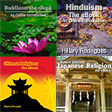Chinese Religions: the eBook
Sample Exam/Review Questions
Essays
Sample essay questions or topics for discussion are available at the end of each of the book's chapters. There are three questions per chapter, for a total of thirty questions.
Multiple Choice Questions
- During the Shang Period, the designation “Shangdi” was applied to the:
- Shang prince.
- Highest deity.
- Head priest of the state cult.
- Regal Ancestor.
- Confucius primarily viewed himself as:
- Creator of a new religious system.
- Restorer and transmitter of traditional wisdom and values.
- Advocate for institutions introduced by contemporary rulers.
- Social reformer concerned with new solutions to societal problems.
- The famous passage in which the author describes dreaming of being a butterfly–and then reflects on his identity, the identity of the butterfly, and the transformation of all things–appears in which text?
- Mengzi (Mencius).
- Xunzi.
- Laozi (Daode jing).
- Zhuangzi.
- Which among these distinctive features/ tendencies is not characteristic of Zhuangzi?
- Predisposition towards interiorization.
- Presentation of positive images of the Perfected (zhenren).
- Endorsement of meditation techniques.
- Praise of governmental service.
- According to traditional sources, the origin of the Shangqing (Supreme Clarity) texts can be traced to:
- Laozi's revelations to Zhang Daoling.
- Celestial beings' revelations to Yang Xi.
- They were composed by Ge Xuan.
- They were compiled by Tao Hongqing.
- What was the broader historical context that influenced the emergence of the Shanqing tradition of Daoism in medieval China?
- Political takeover of the South by northerners fleeing the non-Chinese dynasties in the North.
- Migration of the Celestial Masters tradition back to Sichuan.
- Southerners acceptance of Northerners supremacy and fascination with their religious culture.
- Weakening of the Lingbao school and decline of Daoist ritual traditions.
- What is the main focus of the Lingbao (Numinous Treasure) tradition of Daoism?
- Performance of ritual.
- Practice of meditation.
- Engagement in pious works.
- Ingestion of drugs and potions.
- In terms of its social organization, the early Shangqing tradition can best be described as:
- New monastic order modeled on the Buddhist Sangha.
- Popular religious movement diffused among the common people.
- Grouping of aristocrats with family connections and common religious interests.
- It completely lacked any form of social organization or religious structure.
- The notion of patriarchal lineage is most central to which of the following schools of Chinese Buddhism?
- Chan.
- Tiantai.
- Pure Land.
- Huayan.
- Which of the following is not one of the five precepts in Buddhism?
- Abstention from stealing.
- Abstention from gluttony.
- Abstention from sexual misconduct.
- Abstention from consuming alcohol.
- When were the Neo-Confucian teachings formally accepted as official orthodoxy by the Chinese state?
- They were never recognized as an official orthodoxy by the Chinese state.
- With the establishment of Neo-Confucianism as official orthodoxy under the early Ming dynasty (1368-1644).
- In 1195, five years before Zhu Xi's death, when his teachings were honored by the Song court.
- In 1668, when a Manchu emperor adopted Neo-Confucianism as official ideology of the Qing empire.
- Which of the following was not one of the Four Books popularized by Zhu Xi?
- Analects of Confucius.
- Mencius.
- Great Learning.
- Xunzi.
- Who were the first Christians to enter China?
- Members of an early Christian sect that entered Han China seeking refuge from persecution.
- Nestorian Christians who arrived at the court of Taizong during the early Tang era.
- Franciscan friars who came to the Mongol court during the Yuan dynasty.
- Jesuit missionaries who reached China towards the end of the Ming dynasty.
Short Questions and Answers
- List the “five relationships” of Confucianism.
- List the “four ethical principles” (or inborn virtues) that are discussed in Menzi and other Confucian texts.
- “The Dao that can be told is not the eternal Dao / The name that can be named is not the eternal name / The Nameless is the origin of heaven and Earth / The Named is the mother of all things.” Briefly explain the meaning of these lines from the Laozi, esp. in reference to the text's conception of the Dao.
- What are the three main divisions (“three caverns”) in the earliest version of the Daoist canon (Daozang)?
- Explain who Guanyin is and what is his/her importance and role in Chinese Buddhism.
- List the titles of the Four Books, canonized by Neo-Confucianism from the late Song period onward.
- Identify the two main issues that were at the core of the Catholic controversies regarding their missionary strategies in China (17th-18thc.), which pitted the Jesuits against the opponents of acculturation.
- What is the predominant religion among the Uyghur minority in contemporary China?
- What happened to Christianity and Daoism during the Cultural Revolution (roughly 1966-1976)?
- What is the present-day predicament of Falun gong in China and what does that tells us about the Communist government's policies and attitudes towards religion?
- What is the most vibrant and popular religious tradition in contemporary Taiwan?


